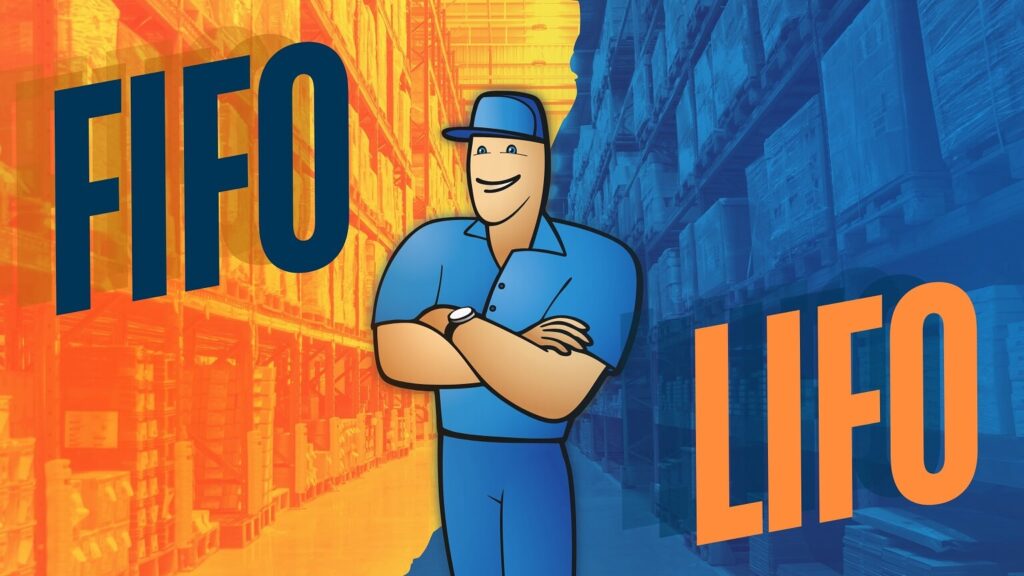FIFO vs. LIFO Inventory Explained
Choosing the right inventory valuation method is a crucial decision for businesses. Deciding between FIFO or LIFO impacts everything from your taxes to how you manage your stock. In this article, we break down the differences between FIFO and LIFO and help you decide which is best for your business.

What are FIFO and LIFO?
FIFO and LIFO are common inventory valuation methods used to understand the value of unsold stock in the balance sheet and inform key financial metrics like the cost of goods sold. FIFO and LIFO are both approved by GAAP – the Generally Accepted Accounting Principles, which is used in the USA. The International Financial Reporting Standards, or IFRS, however, only accepts FIFO of the two.
FIFO (First In, First Out)
FIFO, or first in, first out, assumes that the oldest items you’ve bought or created are the first items you use or sell. When new stock comes in, the older items are moved to the front so they’re sold first. This way, nothing goes bad, and nothing becomes outdated.
With this method, your product’s final cost is based on the price you paid for the oldest inventory. FIFO inventory valuation is great for businesses that deal with perishable goods or products that can quickly lose value, such as food products or tech gadgets.
LIFO (Last In, First Out)
LIFO, or last in, first out, is a valuation method that assumes the most recent inventory you’ve bought or produced are the first ones to be sold or used. With LIFO, the cost of inventory of the most recently purchased is used for the cost of goods sold (COGS) on your financial statements. LIFO inventory valuation can be helpful when prices are going up because it matches higher costs with your sales. However, it might leave your older inventory valued at outdated prices.
LIFO is useful in industries where prices change often or where reducing taxable income during inflation is important. But keep in mind that LIFO isn’t accepted under international accounting standards, so U.S. companies active internationally will always report stock value using both methods.
Other common accounting methods
There are other inventory valuation methods which you may consider using. Specific Identification (SI) tracks the cost of each specific item of inventory. As such, it can be cumbersome and is often reserved for high-value or unique, made-to-order items.
Weighted Average Cost (WAC) calculates the average cost of all items available in your inventory over a period of time. It is useful for smoothing price fluctuations and is often used by companies with large inventories of undifferentiated products.
Why should you use FIFO?
Here’s why you should consider FIFO as your inventory management system:
- Manage inventory with ease. FIFO makes it easier to manage your stock because it guarantees that your oldest items are sold or used first. This is especially important if you’re dealing with products that can spoil or go out of date, like food or tech items. By using up older stock first, you reduce waste and keep your inventory fresh.
- Accurate financial statements. The FIFO method often gives a more accurate picture of your inventory’s value because it matches the cost of older stock with your sales. This method usually aligns with how goods move through your business, making it easier to track and report costs.
- Less risk of the outdated stock. With FIFO, older inventory is less likely to sit around and become obsolete. This method helps you regularly clear out older items, so you’re not stuck with products that can’t be sold.
- Better profits in inflation. When prices are rising, FIFO can lead to a lower costs of goods sold (COGS) because it’s based on older, cheaper inventory. This means higher profit margins since you’re selling at current prices but using older, lower-cost stock.
- Easier tax reporting. FIFO is accepted under both U.S. and international accounting standards, making it a simple choice for businesses that need to follow various reporting rules. This helps streamline your tax reporting process.
Why should you not choose FIFO?
Although FIFO has many benefits for the right manufacturer, it also has drawbacks. Let’s take a closer look at why FIFO may not be the right choice for your inventory management method.
- Higher taxes in inflation. When prices are going up, FIFO can lead to higher taxes because it matches older, cheaper inventory costs with current sales prices. This increases your reported profits, which can mean a bigger tax bill.
- Less realistic profit margins in rising markets. FIFO might not give you a true picture of your profit margins in a market where prices are steadily increasing. Since you’re using older costs, your profits might look better on paper than they are, which can lead to less informed business decisions.
- Potential for outdated inventory on the books. While FIFO helps move older stock first, it can still leave you with outdated inventory on the books, especially if your sales don’t keep up with your most recent purchases. This can lead to inaccuracies in your financial statements over time.
- Not the best for non-perishable items. If your inventory doesn’t spoil or go out of date, FIFO might not offer the same benefits. LIFO might be better suited to maximizing your profits and managing costs effectively.
Why should you use LIFO?
Here’s why LIFO might be a good fit for your business:
- Tax perks when prices rise. The LIFO method can be handy when costs are going up because it matches the higher-priced, newest inventory with your current sales. This can lower your taxable income and, in turn, reduce your tax bill.
- Reflects current costs better. LIFO often gives you a more realistic view of your profit margins during inflation. By using the most recent costs, your financial statements better mirror what’s happening in the economy, helping you make smarter business decisions.
- Great for non-perishable items. If your products don’t spoil or lose value over time, LIFO can be a solid choice. It allows you to keep older stock on the books at lower costs while using the latest prices for accounting.
- Keeps your financials realistic. LIFO helps prevent older, lower-cost inventory from making your financial statements look artificially inflated, which is especially useful if prices are changing frequently in your industry.
Why should you not choose LIFO?
LIFO has its upsides, but it’s not for everyone. Here’s why LIFO might not be the best choice for your business:
- Not accepted worldwide. One big downside of LIFO is that it’s not allowed under international accounting standards (IFRS). If you operate globally or plan to expand, this could be a significant issue.
- Outdated inventory values. LIFO can leave older inventory on your books at lower costs, which might not reflect what that inventory is worth now. This can create a gap between what you have and what’s shown in your financials.
- Lower profits in a falling market. If prices are dropping, LIFO can make your profits look smaller because it uses the higher costs of recent inventory. This might make your business appear less profitable than it is.
- More complicated tracking. LIFO requires you to keep detailed records, especially when it comes to tracking different layers of inventory costs. This can make your accounting more complex and time-consuming.
What’s the right choice for your business?
Deciding between FIFO and LIFO can be a complicated choice. What’s right for your business? Here’s how to figure it out:
Is your inventory perishable or non-perishable?
If you manufacture products that can expire, such as food or pharmaceuticals, FIFO might be your best option. That’s because FIFO makes sure you’re selling the oldest items first. In a similar vein, it’s worth mentioning FEFO (First Expired, First Out), which is very similar to FIFO, but specifically works based on expiry dates of goods. If your products don’t spoil (think hardware or furniture), LIFO may be better. LIFO matches the most recent costs with your current sales, which is great if and when prices go up.
How will it impact your taxes?
The inventory method you choose can have a huge impact on your taxes. LIFO can lower your taxable income during inflation because it uses the most recent, higher-cost inventory. The result? You may owe less in taxes. However, keep in mind that LIFO isn’t accepted under international accounting standards (IFRS). If your business is U.S.-based, LIFO may be an option, but if you operate globally or plan to expand internationally, you won’t be able to stick to just LIFO.
What’s the current state of the economy?
Is the economy experiencing inflation or deflation? You may not realize how big of a role the economy plays in your choice between FIFO and LIFO.
When you’re in an inflationary period and prices are rising, LIFO can help you manage your increasing costs. This is because LIFO reflects the more current (higher) costs. But the downside is that LIFO could make your profits look smaller. On the other hand, FIFO is more likely to show higher profits on paper because it uses the older, cheaper costs. That said, FIFO might also lead to a higher tax bill.
How quickly does your inventory move?
Do you have fast or slow inventory turnover? How quickly do your products sell? If your products move in and out quickly, you have a fast turnover, and FIFO might be the best way to go. FIFO keeps your inventory fresh and ensures you’re always selling your oldest stock first. But if your inventory moves more slowly, LIFO could help you better manage costs, especially when prices are rising.
How easy is it to implement the inventory method?
FIFO is generally more straightforward. It’s relatively easy to implement and manage on a day-to-day basis. LIFO, on the other hand, can be more complex because it requires detailed tracking.
In the end, the best choice for your business depends on what fits your needs and goals. By thinking about how each method impacts your inventory, taxes, financial reporting, and daily operations, you can choose the method that helps your business run smoothly and stay profitable.
How inventory management software can help
Inventory valuation and managing inventory can be challenging, particularly in fast-paced environments where stock moves rapidly, but using inventory management software (IMS) will help. Here’s how:
Takes the guesswork out of inventory
Instead of manually deciding which stock to sell first, the software does it for you. If you choose FIFO, it automatically sells the oldest items first. If you prefer LIFO, it moves the newest stock first, which is handy if prices are rising.
Manages and tracks stock levels
With software, you can see what’s in stock and what’s running low in real-time. A proper IMS tracks everything for you, from serial numbers and production lots to incoming orders and associated costs, so you always know what’s moving fast and what’s not.
Makes financials simple
When it comes to reporting, the software handles the numbers. It calculates the cost of goods sold (COGS) and adjusts your inventory value based on whether you’re using FIFO or LIFO. This makes tax time a breeze and keeps your financial records accurate, which is great when you deal with the IRS.
Fits your business
Every business is different, and good software lets you customize it to fit your needs. Whether you’re dealing with perishable items or long-lasting goods, you can set it up to manage your inventory in a way that works best for you.
Helps you stay compliant
If you’re doing business internationally, you need to follow global accounting rules. IMS software can help you stick to FIFO, ensuring you’re playing by the rules no matter where you operate.
In short, inventory management software takes the hassle out of inventory valuation. It automates stock accounting and product costing, keeps you in the loop with real-time updates, and makes sure your business stays on track.
Key takeaways
- Choose your inventory valuation method based on the types of products you have, such as FIFO for products with an expiration date or LIFO for non-perishable goods.
- Make sure your chosen inventory valuation method aligns with your business’ tax needs and geographic reach.
- Check compliance requirements to ensure your chosen inventory valuation method is acceptable in the jurisdiction in which you operate.
- Fast-moving inventory might benefit from FIFO to keep things fresh while slower-moving stock could be better managed with LIFO.
- FIFO is generally simpler and easier to implement, while LIFO can be more complex and require detailed tracking.
Frequently asked questions
The best choice between LIFO and FIFO depends on your business needs and financial goals. FIFO is ideal for managing perishable goods and provides a straightforward approach, making it widely accepted, including internationally. LIFO, on the other hand, can reduce taxes during inflation but adds complexity and isn’t accepted under global accounting standards. Consider your inventory type, tax strategy, and accounting requirements when deciding.
The FIFO method can show inflated earnings due to using older inventory costs against new pricing. This can result in increased tax liability for your business. On the other hand, LIFO can lower your taxable income by referencing the most recent, higher-cost inventory. As LIFO isn’t accepted under international accounting standards (IFRS), not all companies can use this method.
Once you’ve chosen an inventory valuation method (FIFO, LIFO, or something else), the easiest way to calculate your inventory value is to use inventory management software that automatically calculates it for you. MRPeasy adjusts your inventory value based on the valuation method you have chosen.
The best inventory valuation method depends upon the nature of your products, although companies that are outside the US must follow IFRS (international accounting standards), which doesn’t accept LIFO. Companies that operate within the US can choose FIFO, which is better for products with an expiration date; LIFO, which is usually better for non-perishable goods; or another method, such as Specific Identification or Weighted Average Cost.
You might also like: Work in Process Inventory – What Is WIP and How To Calculate it?




